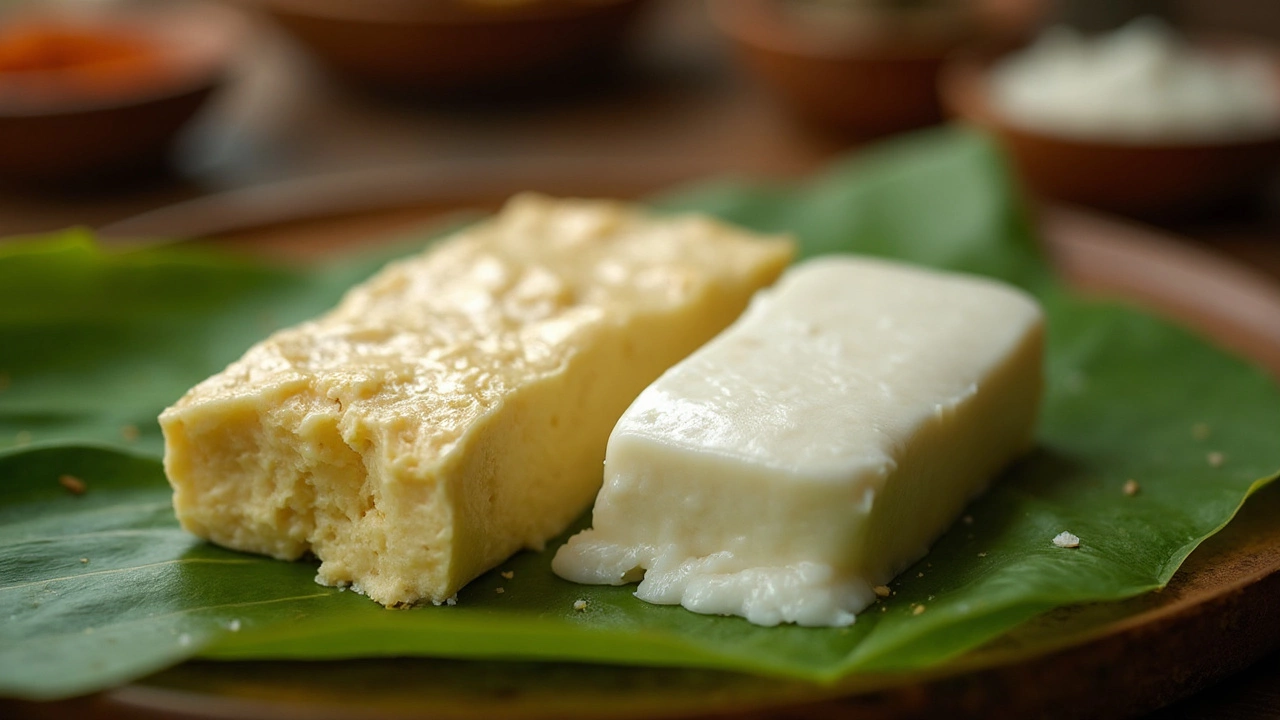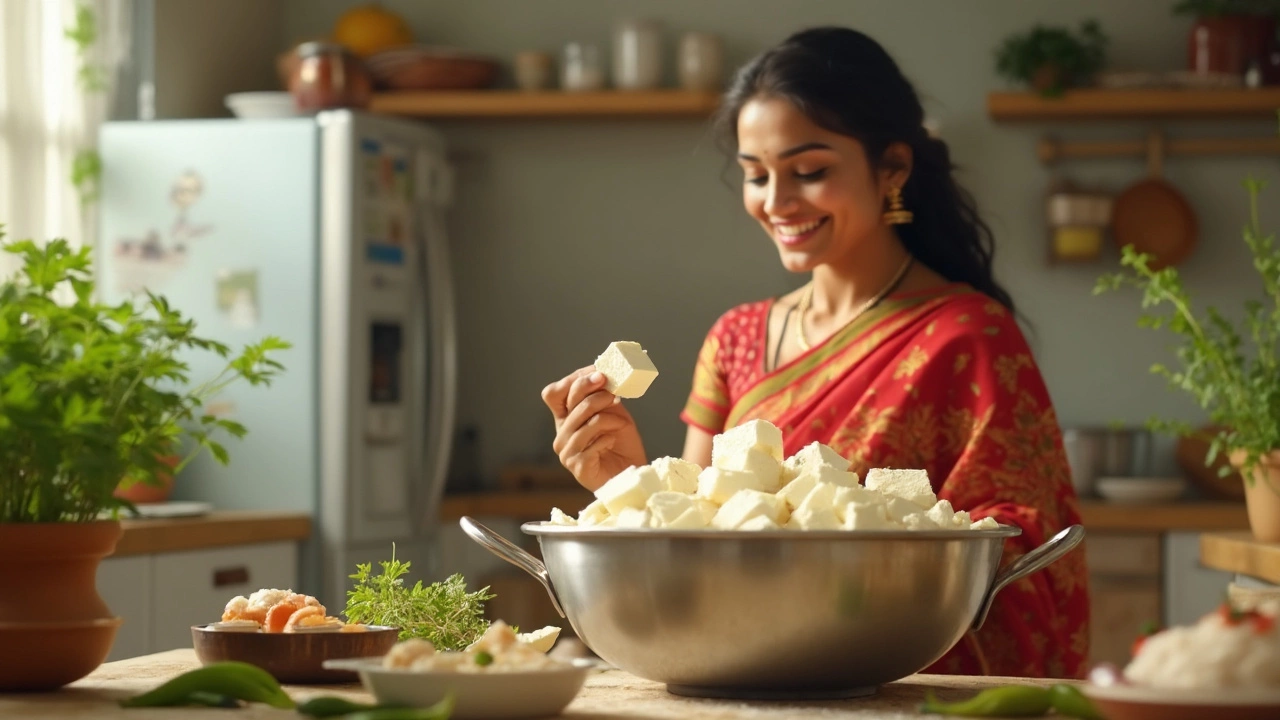If you found a chunk of homemade paneer sitting in your fridge and you're wondering, "Should I risk it on day 10?", you're not alone. We've all lost track of time with leftovers before, but milk-based foods like paneer are a whole different story.
Paneer is fresh cheese. That means it skips any long aging or preservation process. You start with milk, add acid, separate the curds, press—done. No added preservatives. While that's brilliant for taste, it also means homemade paneer has a short shelf life, especially when compared to processed cheeses. So, that little block gets risky pretty fast.
- How Long Does Homemade Paneer Really Last?
- Why 10 Days Is Pushing It
- Signs Your Paneer Has Gone Bad
- Tips to Make Your Paneer Last Longer
How Long Does Homemade Paneer Really Last?
Homemade paneer is basically just pressed curds, and since there’s no salt or preservatives, it doesn’t last long in the fridge. For the best taste and texture, you should eat homemade paneer within 2-3 days if it’s just sitting in a covered container in the fridge. But if you keep it in an airtight box, surrounded by fresh water (changing the water every day), you might stretch it to about 5 to 6 days. After that, things start getting dicey.
The fresher your milk and the cleaner your kitchen, the better your paneer will hold out. Still, it’s not invincible. Day 10 is way past the safe window most food safety experts (and even dairy shops) recommend. Here’s a quick cheat-sheet to keep things clear:
| Storage Method | How Long It Lasts |
|---|---|
| Open bowl in fridge | 2-3 days |
| Airtight container | 3-4 days |
| In water (change daily) | 5-6 days |
| Frozen | 2-3 months (texture changes) |
If you stick to the 2-6 day window, your paneer should stay safe, taste soft, and smell fresh. Once it creeps past that, it’s more likely to go bad, especially since homemade versions don’t have all the safety nets that packaged paneer offers.
One more thing: Always use your senses. If your paneer smells sour, feels slimy, or looks off, don’t even think about cooking with it. Food poisoning is no joke and not worth the risk for a paneer curry.
Why 10 Days Is Pushing It
Pushing your luck with 10 days old paneer isn't a great idea, especially if it's homemade. Homemade paneer doesn't contain preservatives—it's basically just milk, acid (like lemon or vinegar), and maybe a little salt. That means it spoils much faster than store-bought cheese, which often contains chemicals to keep it safe longer.
Here's the thing: homemade paneer usually stays fresh for only 2 to 3 days in the fridge unless you keep it in the coldest part and always in an airtight container. Even then, stretching it to a week is already playing with fire. Most lab tests and food safety guides agree: fresh cheese made from pasteurized milk should be tossed after 1 week in home fridge conditions. If it's made from raw milk, it's even riskier.
| Storage Condition | Recommended Freshness | Max Safe Days |
|---|---|---|
| Regular Refrigerator (4°C/40°F) | 2-3 days | Up to 7 days |
| Air-tight Container | 3-5 days | Up to 7 days |
| Frozen (-18°C/0°F) | 1-2 months (texture changes) | 2 months |
Bacteria like Listeria and E. coli can start growing on homemade paneer if it's around too long. You can't see or smell these bugs until things get really bad—and by then, you're risking food poisoning. Symptoms usually show up fast: think stomach cramps, vomiting, diarrhea. Not the kind of surprise anyone wants from their lunch.
If your homemade paneer is more than 7 days old, it's safest to toss it. If you used unboiled milk or left the paneer out room temperature longer than 2 hours, you should toss it even sooner. Taste and texture might not change much, but the invisible bacteria is the real problem. Don't rely on just sniffing or poking—10 days is just too long to be safe.

Signs Your Paneer Has Gone Bad
Not every paneer is created equal, and homemade paneer is even pickier about storage. Sometimes, it might look fine at first glance, but a closer check tells a different story. Don't just rely on the date—use your senses. Here’s how you can tell your paneer is past its prime:
- Smell: Fresh paneer has a mild, milky aroma. If you catch even a whiff of sourness or something off, it’s likely spoiled. Funky or outright stinky smells? Don’t even think about tasting it.
- Texture: Homemade paneer should be firm and soft, never slimy or sticky. If it feels wet, squishy, or you see gooey spots, toss it.
- Color: Any yellowing, green, or pinkish patches mean trouble. Even small discolored spots can signal mold or bacterial growth.
- Taste (last resort): If it passes the above tests but you’re still unsure, try a tiny bit. Spoiled paneer tastes sour or bitter instead of fresh and creamy.
These warning signs aren’t just a matter of taste—they’re a matter of safety. Dairy can go bad quickly, and eating spoiled paneer can cause food poisoning. Typical symptoms are stomach pain, diarrhea, and vomiting, which can become serious for kids or older adults.
| Sign | Likely Cause |
|---|---|
| Sour smell | Bacterial spoilage |
| Slime or sticky feel | Lactic acid bacteria/mold |
| Color patches (green/yellow/pink) | Mold growth |
| Sour or bitter taste | Protein breakdown/spoilage |
Still unsure? When it comes to homemade dairy, trust your senses and, if in doubt, throw it out. No homemade paneer is worth a night of stomach pain.
Tips to Make Your Paneer Last Longer
If you love making paneer at home, you know how quickly it can go off if you’re not careful. The good news? A little planning helps your homemade cheese hang around for days without turning dodgy.
- Store it in the fridge immediately: Get your fresh paneer into an airtight container as soon as it's cool. Don’t leave it out at room temperature for more than two hours, especially in summer.
- Cover with water: Covering paneer cubes in clean, cold water inside the container slows down drying and keeps the texture soft. Change the water daily to prevent a funky smell.
- Airtight is non-negotiable: Use a container with a good seal. Any gap lets in fridge odors or bacteria.
- Freeze if you won’t use it soon: Not planning to cook within three days? Cut the paneer into usable portions, wrap them tightly in cling film or foil, and freeze. Thaw in the fridge, not at room temperature.
- Check for sour smell or sliminess before using: Always give paneer a quick sniff and touch check. If it feels slimy or smells even a little sour, don’t risk it.
Just to give you a handy side-by-side, here’s how long you can expect homemade paneer to last based on how you store it:
| Storage Method | Lifespan | Extra Tip |
|---|---|---|
| Plain in the fridge | 2-3 days | Use airtight container |
| In water (change daily) | Up to 5 days | Water must be fresh and cold |
| In freezer (airtight, portioned) | Up to 2 months | Label with date before freezing |
Packed right, homemade paneer will taste fresh even after a few days. If you ever spot mold, toss it immediately. No amount of trimming can save contaminated paneer. Freezing does change the texture a bit, but for cooked dishes like palak paneer or curries, you’ll barely notice the difference.
